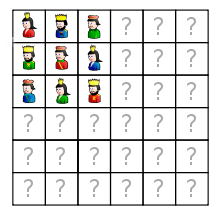Thirty-six officers problem

The thirty-six officers problem is a mathematical puzzle proposed by Leonhard Euler in 1782.[1][2]
The problem asks if it is possible to arrange six regiments consisting of six officers each of different ranks in a 6 × 6 square so that no rank or regiment will be repeated in any row or column. Such an arrangement would form a Graeco-Latin square. Euler correctly conjectured there was no solution to this problem, and Gaston Tarry proved this in 1901,[3][4] but the problem has led to important work in combinatorics.[5]
Besides the 6 × 6 case the only other case where the equivalent problem has no solution is the 2 × 2 case, i.e. when there are four officers.
See also
- 36 cube
References
- ↑ Euler, L., Recherches sur une nouvelle espece de quarres magiques (1782).
- ↑ P. A. MacMahon (1902). "Magic Squares and Other Problems on a Chess Board". Proceedings of the Royal Institution of Great Britain XVII: 50–63.
- ↑ Tarry, Gaston (1900). "Le Probléme de 36 Officiers". Compte Rendu de l'Association Française pour l'Avancement de Science Naturel (Secrétariat de l'Association) 1: 122–123.
- ↑ Tarry, Gaston (1901). "Le Probléme de 36 Officiers". Compte Rendu de l'Association Française pour l'Avancement de Science Naturel (Secrétariat de l'Association) 2: 170–203.
- ↑ Dougherty, Steven. "36 Officer Problem." Steven Dougherty's Euler Page. 4 Aug 2006.
External links
- Euler's Officer Problem at Convergence
- 36 cube A puzzle that uses this problem.
- Weisstein, Eric W., "36 Officer Problem", MathWorld.
- Euler Square Web Application at GitHub
- Web application on Euler squares / Graeco-Latin squares of order 1x1 to 10x10 for Firefox compatible browsers and HTML5 mobile devices. The 36 officers problem searches for a solution of a Graeco-Latin square of order 6x6.